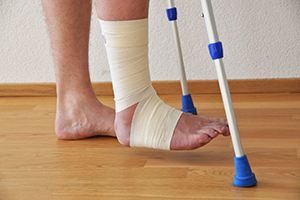Health Blog
Specific exercises and hands-on therapy is helpful for ankle sprains

Many patients who experience one ankle sprain go on to have long-term issues
Ankle sprains are the most common injury in athletes and those who are physically active. These injuries can occur anywhere in the ankle, but sprains to the outside of the ankle (lateral ankle sprains) are most typical and account for about 85% of sprains. In addition to the initial pain and disability that these injuries cause, up to 40% of patients who sprain their ankle once will go on to develop a condition called chronic ankle instability. Individuals with chronic ankle instability tend to experience continual pain and soreness, and a sensation that the ankle is "giving way." As a result, they are more likely to sprain their ankle again, which can lead to serious long-term issues. Two strategies used by physical therapists for treating these patients are manual therapy and exercise therapy. Manual therapy consists of different types of mobilizations being applied to the patient's ankle by the therapist, while exercise therapy involves various exercises designed to improve balance and increase strength. Both treatments have been found to lead to benefits, but it's not completely clear what effect they have when used together. Therefore, a randomized-controlled trial (RCT) was conducted to investigate the combination of these treatments for patients with chronic ankle instability. An RCT randomly places participants in different treatment groups to see which is more effective and is considered the most powerful type of individual study.
Sample of patients randomly assigned to one of two groups
Individuals who reported having recurring ankle sprains were recruited for the study and screened to determine if they were eligible. Out of 68 people screened, 56 fit the necessary criteria and were randomly assigned to one of two treatment groups. Both treatment groups 1 and 2 followed an exercise therapy treatment program that was given during two sessions per week for four weeks. Sessions consisted of six different exercises that were designed to increase strength and improve proprioception, which is the body's ability to sense its position in space during movements. These exercises were supervised by two physical therapists and progressed each week based on patients' abilities. In addition to exercise therapy, treatment group 2 also received manual therapy over the course of four weeks. This consisted of therapists performing a series of mobilizations of the ankle joint with the goal of improving patients' ankle mobility. Each technique lasted 20-30 seconds and was repeated 10 times each by the therapists. All patients were evaluated for pain, ankle stability, pain threshold, strength and flexibility before the study, immediately after treatment and then again one month later.
Adding manual therapy leads to even greater outcomes
Results showed that although both groups reported better overall scores in all the measurements taken, those in treatment group 2 experienced greater improvements than treatment group 1. This was based on lower levels of pain, better ankle stability and greater flexibility, pain threshold and strength in participants who had the treatment combination. These findings suggest that exercises for strength and proprioception can be very effective on their own for helping patients with chronic ankle instability, but adding manual therapy to the treatment program may likely lead to even greater outcomes for them. Therefore, patients with chronic ankle instability who continue to sprain their ankle should seek out physical therapy services to address their condition. By combining exercise therapy for strength and proprioception and manual therapy, physical therapists can produce noticeable improvements in these patients and help them to function better with a reduced risk for additional ankle sprains.
-As reported in the August '16 issue of Manual Therapy
October 6, 2017
Back to Health BlogHEALTH BLOG
- Exercise Therapy May Provide Relief for Chemotherapy-Related Issues
- Unlocking Relief From Elbow Pain With Hands-On Therapy and Exercise
- Are Deep Squats Really as Bad as We Think?
- Reclaiming Your Grip: The Power of Hands-On Therapy for Tennis Elbow
- Runners Can Overcome a Common Knee Condition With Physical Therapy
- How Physical Therapy Can Help Older Adults Stay on Their Feet
- What You Need to Know About Alcohol and Heart Health
- Exercise Therapy Provides Strong Evidence of Its Effectiveness
- Strength in Age: The Power of Resistance Training for Older Adults
- Hip Strength and Groin Pain: What Athletes Need to Know
RECENT ARTICLES

- 11 Possible Reasons Your Back HurtsJune 22, 2020

- What Conditions Can a Chiropractor Treat?May 25, 2020

- A Simple Guide to Better PostureApril 30, 2020

- Is Acupuncture Right for Me When I’m Afraid of Needles?March 30, 2020

- Stretching Done Right — How and When to StretchFebruary 26, 2020

